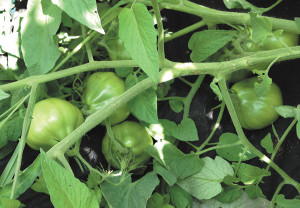A few weeks ago I went on a tirade about my hatred of weeds, so I thought I’d balance things out by talking about my love of bees. I love all (almost all) animals, but my top two are dogs and bees. While dogs are a no-no in the garden (at least my garden, you may be more accepting of trampled plants), I encourage bees at every turn, even leaving some bee-friendly weeds around to encourage their visits.
Honey bees and bumble bees have been working overtime in the garden, and I’ve been very careful not to disturb their labors. Recently, correspondent Cynthia Orr shared that she’s let the clover in her yard grow and is enjoying the bees buzzing around. People who are allergic to bees (my mother was one of them) find the idea of a bee-friendly lawn terrifying, and rightfully so. But there is something hypnotic about watching them go from flower to flower, doing their bee-thing. They combine athleticism and grace like ballet dancers.
The bee is a critical part of the food chain. Without their pollination skills, we’d be left eating grain, potatoes, and a few other crops (besides meat, of course). Other insects also pollinate plants, but none quite as effectively as the bee. They also produce honey and beeswax, which are also useful things.

Ethel Winslow/ Weekly View
Little things cause big things to happen, like the estimated jillion tomatoes in the garden.
My bees (they aren’t really mine, they’re just visitors) are responsible for the huge number of baby tomatoes I currently have in the vegetable garden. I’m conservatively estimating I’ve got a jillion tomatoes at various stages of development, plus a dozen cantaloupe and a bunch of peppers and cukes. Four tomato cages have toppled over and I’ve had to do emergency staking. And the bees keep buzzing happily in and out, just doing their job.
In spring when the apple blossoms came out, my grandfather’s orchard hummed with bees. A local beekeeper would bring several hives over and park them near the pine trees at the end of the lane. We kids knew better than to bother the bees when they were working. I used to watch them fly back and forth from the hive to the trees on warm days like a horde of teenage boys at an all-you-can-eat buffet. I’d see them working over the trees and think “there’s another apple for fall.” In all the time I spent on the farm, I was only stung once — in the head. I discovered two things: I’m not allergic to bees, and it takes three people to find and pull a stinger out of a screaming teenager’s scalp.
The beekeeper would remove the honey at the end of the season, bottle it up or cut it into combs, and we’d sell it in the store. Grandpa owed a lot to those bees, who worked so hard to give us so much.
Beginning in the early 2000s, reports of a decline in the number of bees made the news. In 2007, about 30-70 percent of honey bee hives died off, setting off alarm bells that agriculture as we know it was in jeopardy. Colony Collapse Disorder is a real thing, and no one knows why it is happening, though there are theories that the over-use of chemicals and genetically altered plants may be to blame. One thing is certain, though — the importance of bees to our food systems cannot be overstated.
The latest urban trend is to tend bees in the city. This is part of the “urban farmstead” trend (some say fad, but let’s not quibble) that encourages the raising of chickens, dairy goats, ducks, vegetable gardens, and small orchards in the confines of a city. I know a few people who are keeping bees and are enjoying the experience. I hope their bees continue to make it to my yard, where they are welcome to work among the blossoms.



